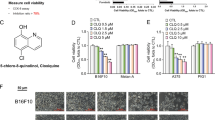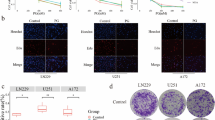Abstract
Cordyceps sinensis, a parasitic fungus on the larvae of Lepidoptera, has been used as a traditional Chinese medicine. We previously reported that the growth of B16-BL6 mouse melanoma (B16-BL6) cells was inhibited by cordycepin (3′-deoxyadenosine), an active ingredient of C. sinensis, and its effect was antagonized by MRS1191, a selective adenosine A3 receptor antagonist. In this study, the radioligand binding assay using [125I]-AB-MECA (a selective adenosine A3 receptor agonist) has shown that B16-BL6 cells express adenosine A3 receptors and that cordycepin binds to these receptors. We also confirmed the involvement of adenosine A3 receptors in the action of cordycepin using MRS1523 and MRS1220, specific adenosine A3 receptor antagonists. Next, indirubin, a glycogen synthase kinase-3β (GSK-3β) inhibitor, antagonized the growth suppression induced by cordycepin. Furthermore, the level of cyclin D1 protein in B16-BL6 cells was decreased by cordycepin using Western blot analysis. In conclusion, this study demonstrated that cordycepin inhibits the proliferation of B16-BL6 cells by stimulating adenosine A3 receptors followed by the Wnt signaling pathway, including GSK-3β activation and cyclin D1 inhibition.




Similar content being viewed by others
References
Bar-Yehuda S, Madi L, Silberman D, Gery S, Shkapenuk M, Fishman P (2005) CF101, an agonist to the A3 adenosine receptor, enhances the chemotherapeutic effect of 5-fluorouracil in a colon carcinoma murine model. Neoplasia 7:85–90
Chung H, Jung JY, Cho SD, Hong KA, Kim HJ, Shin DH, Kim H, Kim HO, Shin DH, Lee HW, Jeong LS, Kong G (2006) The antitumor effect of LJ-529, a novel agonist to A3 adenosine receptor, in both estrogen receptor-positive and estrogen receptor-negative human breast cancers. Mol Cancer Ther 5:685–692
Cunningham KG, Mason W, Spring FS, Hutchinson SA (1950) Cordycepin, a metabolic product isolated from cultures of Cordyceps militaris (Linn.). Nature 166:949
Fishman P, Bar-Yehuda S, Madi L, Cohn J (2002) A3 adenosine receptor as a target for cancer therapy. Anticancer Drugs 13:437–443
Fredholm BB, Ijzerman AP, Jacobson KA, Klotz KN, Linden J (2001) International Union of Pharmacology. XXV. Nomenclature and classification of adenosine receptors. Pharmacol Rev 53:527–552
Lee EJ, Min HY, Chung HJ, Park EJ, Shin DH, Jeong LS, Lee SK (2005) A novel adenosine analog, thio-Cl-IB-MECA, induces G0/G1 cell cycle arrest and apoptosis in human promyelocytic leukemia HL-60 cells. Biochem Pharmacol 70:918–924
Lu J, Pierron A, Ravid K (2003) An adenosine analogue, IB-MECA, down-regulates estrogen receptor alpha and suppresses human breast cancer cell proliferation. Cancer Res 63:6413–6423
Madi L, Bar-Yehuda S, Barer F, Ardon E, Ochaion A, Fishman P (2003) A3 adenosine receptor activation in melanoma cells: Association between receptor fate and tumor growth inhibition. J Biol Chem 43:42121–42130
Madi L, Ochaion A, Rath-Wolfson L, Bar-Yehuda S, Erlanger A, Ohana G, Harish A, Merimski O, Barer F, Fishman P (2004) The A3 adenosine receptor is highly expressed in tumor versus normal cells: Potential target for tumor growth inhibition. Clin Cancer Res 10:4472–4479
Merighi S, Benini A, Mirandola P, Gessi S, Varani K, Leung E, Maclennan S, Borea PA (2005) A3 adenosine receptor activation inhibits cell proliferation via phosphatidylinositol 3-kinase/Akt-dependent inhibiton of extracellular signal-regulated kinase 1/2 phosphorylation in A375 human melanoma cells. J Biol Chem 280:19516–19526
Nakamura K, Konoha K, Yoshikawa N, Yamaguchi Y, Kagota S, Shinozuka K, Kunitomo M (2005) Effect of cordycepin (3′-deoxyadenosine) on hematogenic lung metastatic model mice. In Vivo 19:137–142
Nakamura K, Yoshikawa N, Yamaguchi Y, Kagota S, Shinozuka K, Kunitomo M (2006) Antitumor effect of cordycepin (3′-deoxyadenosine) on mouse melanoma and lung carcinoma cells involves adenosine A3 receptor stimulation. Anticancer Res 26:43–48
Panjehpour M, Karami-Tehrani F (2004) An adenosine analog (IB-MECA) inhibits anchorage-dependent cell growth of various human breast cancer cell lines. Int J Biochem Cell Biol 36:1502–1509
Thomadaki H, Tsiapalis CM, Scorilas A (2005) Polyadenylate polymerase modulations in human epithelioid cervix and breast cancer cell lines, treated with etoposide or cordycepin, follow cell cycle rather than apoptosis induction. Biol Chem 386:471–480
Wu WC, Hsiao JR, Lian YY, Lin CY, Huang BM (2007) The apoptotic effect of cordycepin on human OEC-M1 oral cancer cell line. Cancer Chemother Pharmacol 60:103–111
Yoshikawa N, Nakamura K, Yamaguchi Y, Kagota S, Shinozuka K, Kunitomo M (2004) Antitumour activity of cordycepin in mice. Clin Exp Pharmacol Physiol 31:S51–S53
Yoshikawa N, Nakamura K, Yamaguchi Y, Kagota S, Shinozuka K, Kunitomo M (2007) Cordycepin and Cordyceps sinensis reduce the growth of human promyelocytic leukemia cells through the Wnt signaling pathway. Clin Exp Pharmacol Physiol 34:S61–S63
Acknowledgments
This research was supported, in part, by Grants-in-Aid for Scientific Research (C) (18590127), Young Scientists (B) (19790101), and Joint Research of Industries and University from the Ministry of Education, Culture, Sports, Science and Technology of Japan.
Author information
Authors and Affiliations
Corresponding author
Rights and permissions
About this article
Cite this article
Yoshikawa, N., Yamada, S., Takeuchi, C. et al. Cordycepin (3′-deoxyadenosine) inhibits the growth of B16-BL6 mouse melanoma cells through the stimulation of adenosine A3 receptor followed by glycogen synthase kinase-3β activation and cyclin D1 suppression. Naunyn-Schmied Arch Pharmacol 377, 591–595 (2008). https://doi.org/10.1007/s00210-007-0218-y
Received:
Accepted:
Published:
Issue Date:
DOI: https://doi.org/10.1007/s00210-007-0218-y




